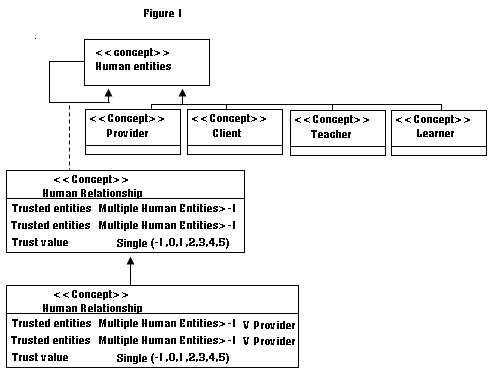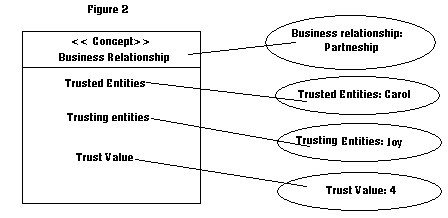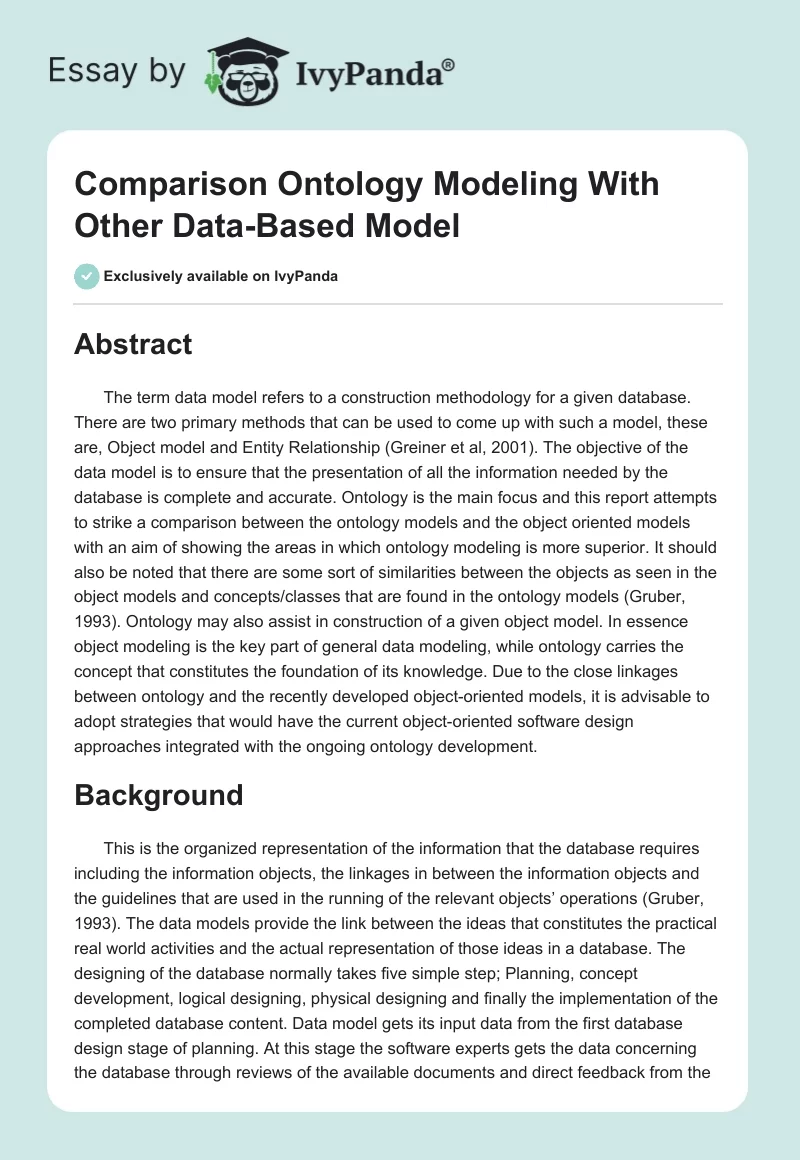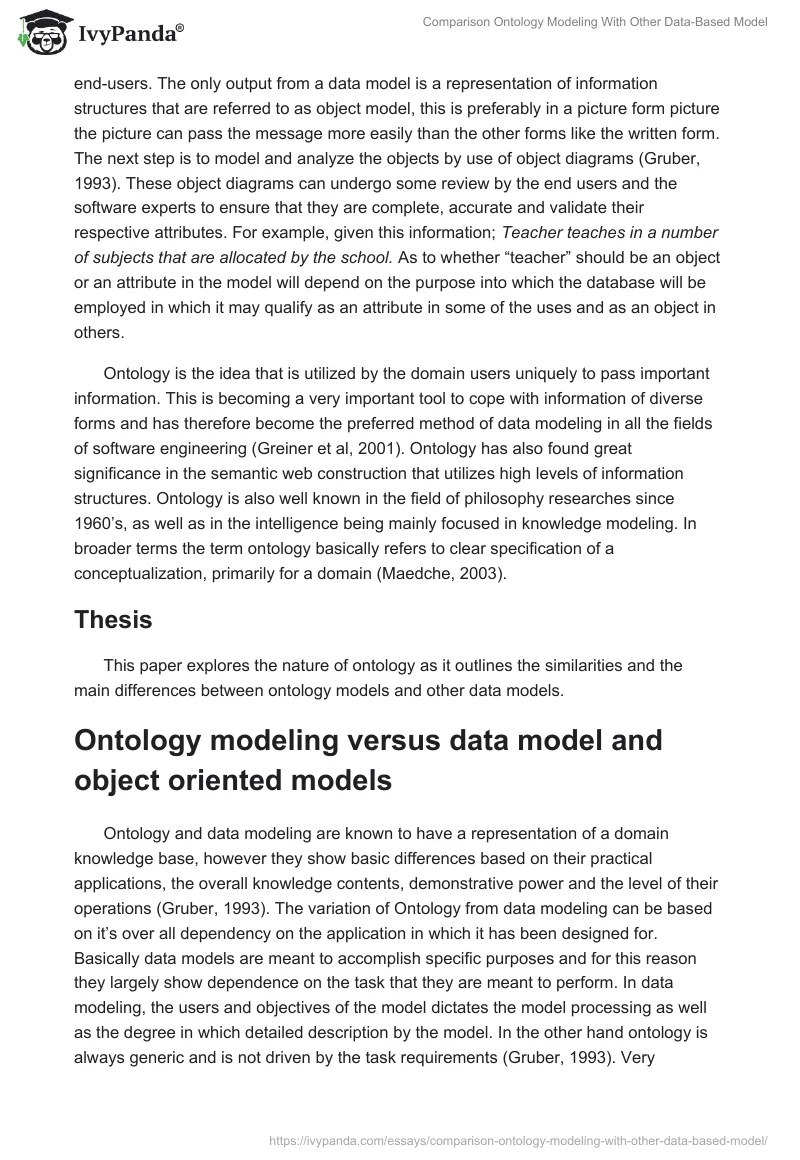Abstract
The term data model refers to a construction methodology for a given database. There are two primary methods that can be used to come up with such a model, these are, Object model and Entity Relationship (Greiner et al, 2001). The objective of the data model is to ensure that the presentation of all the information needed by the database is complete and accurate. Ontology is the main focus and this report attempts to strike a comparison between the ontology models and the object oriented models with an aim of showing the areas in which ontology modeling is more superior. It should also be noted that there are some sort of similarities between the objects as seen in the object models and concepts/classes that are found in the ontology models (Gruber, 1993). Ontology may also assist in construction of a given object model. In essence object modeling is the key part of general data modeling, while ontology carries the concept that constitutes the foundation of its knowledge. Due to the close linkages between ontology and the recently developed object-oriented models, it is advisable to adopt strategies that would have the current object-oriented software design approaches integrated with the ongoing ontology development.
Background
This is the organized representation of the information that the database requires including the information objects, the linkages in between the information objects and the guidelines that are used in the running of the relevant objects’ operations (Gruber, 1993). The data models provide the link between the ideas that constitutes the practical real world activities and the actual representation of those ideas in a database. The designing of the database normally takes five simple step; Planning, concept development, logical designing, physical designing and finally the implementation of the completed database content. Data model gets its input data from the first database design stage of planning. At this stage the software experts gets the data concerning the database through reviews of the available documents and direct feedback from the end-users. The only output from a data model is a representation of information structures that are referred to as object model, this is preferably in a picture form picture the picture can pass the message more easily than the other forms like the written form. The next step is to model and analyze the objects by use of object diagrams (Gruber, 1993). These object diagrams can undergo some review by the end users and the software experts to ensure that they are complete, accurate and validate their respective attributes. For example, given this information; Teacher teaches in a number of subjects that are allocated by the school. As to whether “teacher” should be an object or an attribute in the model will depend on the purpose into which the database will be employed in which it may qualify as an attribute in some of the uses and as an object in others.
Ontology is the idea that is utilized by the domain users uniquely to pass important information. This is becoming a very important tool to cope with information of diverse forms and has therefore become the preferred method of data modeling in all the fields of software engineering (Greiner et al, 2001). Ontology has also found great significance in the semantic web construction that utilizes high levels of information structures. Ontology is also well known in the field of philosophy researches since 1960’s, as well as in the intelligence being mainly focused in knowledge modeling. In broader terms the term ontology basically refers to clear specification of a conceptualization, primarily for a domain (Maedche, 2003).
Thesis
This paper explores the nature of ontology as it outlines the similarities and the main differences between ontology models and other data models.
Ontology modeling versus data model and object oriented models
Ontology and data modeling are known to have a representation of a domain knowledge base, however they show basic differences based on their practical applications, the overall knowledge contents, demonstrative power and the level of their operations (Gruber, 1993). The variation of Ontology from data modeling can be based on it’s over all dependency on the application in which it has been designed for. Basically data models are meant to accomplish specific purposes and for this reason they largely show dependence on the task that they are meant to perform. In data modeling, the users and objectives of the model dictates the model processing as well as the degree in which detailed description by the model. In the other hand ontology is always generic and is not driven by the task requirements (Gruber, 1993). Very minimum task considerations are evaluated during its design phase. For example, a significant attribute of a human gene is that it offers a unique protein based code. In case this knowledge is not required by the application in case of data modeling, it can be excluded from the design. However, in ontology a representation of agreeable and shared information is essential. Therefore in our gene ontology it is very significant to include the represented protein genes. In that way, the ontology shall be comprised of quite generic information that can often be reused later in other diverse applications to fulfill other different purposes, hence giving ontology a superior advantage over the other models (Spyns et al 2002).
Another way in which ontology differs from the other models is on the quantity and type of knowledge coverage. Whereas data models centers on the establishment of linkages between the database and their respective concepts, the ontology is mainly focused on comprehending by the user, of the knowledge displayed by the model (Greiner et al, 2001). Therefore, ontology is a complete and precise representation of ideas and their linkages. It is considered as the driving coding of a computer network, this is because the knowledge that is considered to be true through a given domain needs not to change significantly in terms of the way it gets organized for storage in a computer network.
Ontology has been seen to have a greater expressive power potential than the other models. Whereas the data models are constructed using common language, ontology constructs utilizes much more expressive language that has the potential of giving expressions to other diverse variables for example taxonomy and inferencing. Ontology model therefore, has the design that keeps the domain conceptualization at high level of precision (Greiner et al, 2001).
Another powerful tool and attribute of ontology is that due to its generic nature and its unique independence from the task and purpose, it operates at a relatively high degree of abstraction (Maedche, 2003). The other data modeling comparatively operates at low levels. For example, a data model can represent a car database based on its physical attributes and a different spare parts database for the same cars probably with some similar attributes like the make and model of the car. This data based models will only have a very narrowed and fixed views of the overall dimension in which the end user would need to be reflected. However the ontology option of the car and spare parts databases can be designed in such a way that the common knowledge between the two databases is linked together for expressive sharing. The shared knowledge and attributes of both databases will run at high levels of abstraction and at the same time, the design will be independent from the specific inbuilt applications that run on both databases. These differences between the ontology and data models are useful tools for modelers and designers for they guide their work in maintaining focus on the stipulated objectives of the desired project (Maedche, 2003).
Ontology modeling parts
The term ontology refers to the study of the types of elements that exist or have the potential of existing in some given domain (Gruber, 1993). Ontology therefore offers a description of the primary concepts within a domain and outlines the relationship among such concepts. Ontology basically consists of ideological concepts and the characteristics of each of these concepts with a description of the concept features and their restrictions on facets. Following is a discussion of ontology model parts that makes it more semantically richer than the other models.
Concept/class
A class represents objects concepts that can either be in groups, sets or collections of objects. The concepts need to be closely linked to the objects and linkages in the domain of interest. The concepts in most cases are represented by nouns for the objects and verbs for the relationships in the description of the domain. Concepts of related terms are well defined in a class and each class can have many subclasses (Gruber, 1993). A class description defines slots and values of the class itself.
Slots/ Facets
Most terms, have own slots that are used to describe the characteristics of the term. We sometimes have instances slot that describes a characteristic of an instances of the class. A slot is used to describe linkages between two terms. The first term must be the domain of the slot and the second term the range of the slot. For example corolla could be represented as a slot such that its domain was car models and its rage was Toyota model. The scope of ontology is defined by a continuous generation of terms. The scope is determined by what we finally decide to include and exclude in the definition. Characteristics of classes can be represented by slots and restrictions on characteristics or linkages between classes and or slots by slot facets (Greiner et al, 2001).
Axioms
Sentences belonging to the 1st order logic that cannot be represented using slots and values on a frame are referred to as axioms (Gruber, 1993). They are generally taken to be true with no documentation of proof. Axioms are represented in prefix form indicating its logic status. (Gruber, 1993).
Instances
These are particular entities derived from the domain base to comprise the primary elements of ontology as contained in defined objects like cars and abstract objects like words. (Gruber, 1993).
Relationship
A relation indicates a linkage between two or more terms in a model. If the linkage is only between two terms then it is normally referred to as a slot or binary relation. On the other had we have a description of relationship of n terms in that there is an nth term that corresponds to a given group of the n-1 terms, such a linkage is known as function (Gruber, 1993). Introduction of relations in ontology constitutes conversions of structures that are easy to comprehend into complex ones that are difficult to interpret. As a result, entities may have more than one source. Ontologies further refine the modeled semantics by increasing the number of parts in the relationship in such a way that they become useful in answering particular questions that are based on a specific domain. (Gruber, 1993).
Functions
A relation that relates a given set of terms to specified second set of terms is referred as a function. In such a relation, there are no group-sets of n terms are comprised of the same initial n-1 terms. A special function that comprises of only two terms can be referred to as a slot (Gruber, 1993).
Standards and language
Semantic web is one of the most recent online advancement which works as an extension of the existing system and helps in giving quality definitions of activities and linkages that enable users to work in cooperation. Ontology modeling is so much involved in formation of description and relationships of high precision on the web information and thereby creating workable linkages for users at different geographical stations. Therefore semantic web can significantly be seen as a set of ontologies that create a web environment where users can make use of availed objects and present it for re-use by different applications. (Gruber, 1993).
Ontology based illustrations
Examples based on the ontology model are illustrated here to demonstrate the modeling concepts that represent part of trust ontology. Figure 1 depicts a human relationship that links various entities that are specific to linkages between the provider and the client so as to constitute a typical business relationship. Figure 2 indicates instances of the depicted business relationship. It can be deduced from the ontology illustration that the partnership between Carol and Joy is that of business relationship with a trust value indicated as 4.


Conclusion
This paper has explored the ontology modeling and has compared the model with the other data based model to critically examine its superiority over them. The attributes of the ontology model have been represented in details to show the characteristics that makes the model semantically richer than the other models.
List of references
Greiner, R., Darken, C. and Santoso, N. I. (2001): Efficient reasoning. ACM Computing Surveys 33(1):1–30.
Gruber, T.R. (1993): A translation approach to portable ontology specification, Knowledge Acquisition: pp. 199-220.
Maedche, A.D. (2003): Ontology Learning for the Semantic Web. Norwell, Massachusetts, Kluwer Academic Publishers.
Spyns, P., Meersman, R. and Jarrar, M. (2002): Data modelling versus Ontology engineering. SIGMOD Record 31(4):7-12.


